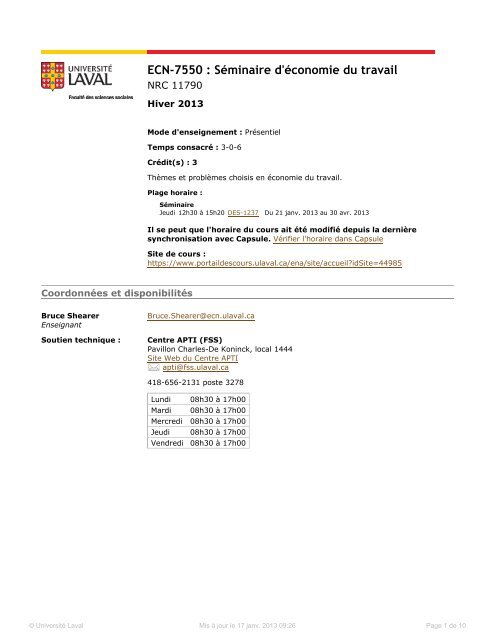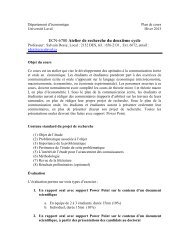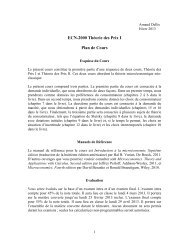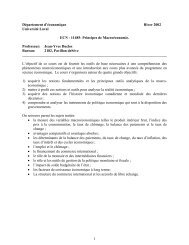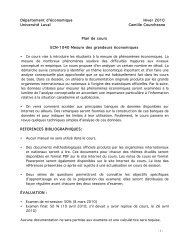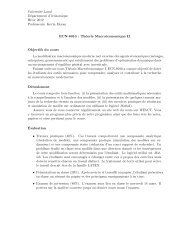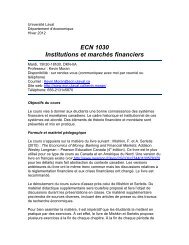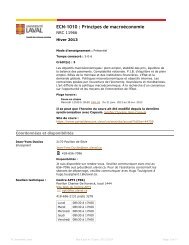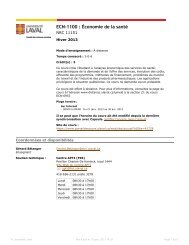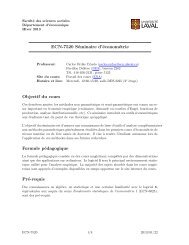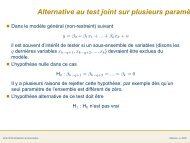Plan de cours - Département d'économique - Université Laval
Plan de cours - Département d'économique - Université Laval
Plan de cours - Département d'économique - Université Laval
- No tags were found...
Create successful ePaper yourself
Turn your PDF publications into a flip-book with our unique Google optimized e-Paper software.
ECN-7550 : Séminaire d'économie du travailNRC 11790Hiver 2013Mo<strong>de</strong> d'enseignement : PrésentielTemps consacré : 3-0-6Crédit(s) : 3Thèmes et problèmes choisis en économie du travail.Plage horaire :SéminaireJeudi 12h30 à 15h20 DES-1237 Du 21 janv. 2013 au 30 avr. 2013Il se peut que l'horaire du <strong>cours</strong> ait été modifié <strong>de</strong>puis la <strong>de</strong>rnièresynchronisation avec Capsule. Vérifier l'horaire dans CapsuleSite <strong>de</strong> <strong>cours</strong> :https://www.portail<strong>de</strong>s<strong>cours</strong>.ulaval.ca/ena/site/accueil?idSite=44985Coordonnées et disponibilitésBruce ShearerEnseignantSoutien technique :Bruce.Shearer@ecn.ulaval.caCentre APTI (FSS)Pavillon Charles-De Koninck, local 1444Site Web du Centre APTIapti@fss.ulaval.ca418-656-2131 poste 3278LundiMardiMercrediJeudiVendredi08h30 à 17h0008h30 à 17h0008h30 à 17h0008h30 à 17h0008h30 à 17h00© <strong>Université</strong> <strong>Laval</strong> Mis à jour le 17 janv. 2013 09:26 Page 1 <strong>de</strong> 10
SommaireDescription du <strong>cours</strong> ......................................................................................................................... 3Introduction .................................................................................................................................. 3Objectif général du <strong>cours</strong> ................................................................................................................ 3Approche pédagogique .................................................................................................................... 3Contenu et activités .......................................................................................................................... 3Évaluations et résultats .................................................................................................................... 3Liste <strong>de</strong>s évaluations ...................................................................................................................... 4Informations détaillées sur les évaluations sommatives ....................................................................... 4Travail <strong>de</strong> session ...................................................................................................................... 4Participation .............................................................................................................................. 4Présentation d'articles ............................................................................................................... 4Présentation du travail <strong>de</strong> session ................................................................................................ 4Examen .................................................................................................................................... 4Barème <strong>de</strong> conversion .................................................................................................................... 4Plagiat .......................................................................................................................................... 5Règles disciplinaires ........................................................................................................................ 5Application <strong>de</strong> la politique sur l'usage du français à l'<strong>Université</strong> <strong>Laval</strong> .................................................... 5Absence à un examen ..................................................................................................................... 6Matériel didactique ........................................................................................................................... 6Matériel informatique et logiciels ...................................................................................................... 6Bibliographie et annexes .................................................................................................................. 7Bibliographie ................................................................................................................................. 7© <strong>Université</strong> <strong>Laval</strong> Mis à jour le 17 janv. 2013 09:26 Page 2 <strong>de</strong> 10
Description du <strong>cours</strong>IntroductionCe <strong>cours</strong> est divisé en <strong>de</strong>ux parties. Dans la première partie, nous discutons une série d'articles sur lesmétho<strong>de</strong>s économétriques utilisées en économie du travail. Nous terminons cette partie en présentant <strong>de</strong>uxsujets d'application: l'évaluation ex-post <strong>de</strong>s politiques et l'évaluation ex-ante <strong>de</strong>s politiques.Dans la <strong>de</strong>uxième partie, chaque étudiant présentera un travail <strong>de</strong> session qui analyse une politique enéconomie du travail. Le but <strong>de</strong> ce travail est <strong>de</strong> présenter une analyse critique d'articles tirés da la littérature.Le travail doit comprendre:i) Une motivation claire <strong>de</strong> l'importance du sujet;ii) Un contexte théorique qui démontre clairement la question à être analysée;iii) Un survol critique <strong>de</strong>s étu<strong>de</strong>s existantes sur la question faisant le lien avec les métho<strong>de</strong>s étudiées en classe;iv) Une conclusion qui pointe dans une direction pour la recherche future.Ce travail fera l'objet d'une présentation d'une heure au mois d'avril et d'un article écrit <strong>de</strong> 15-20 pages(éspace double).Ce plan <strong>de</strong> <strong>cours</strong> peut être changé et sera périodiquement mis à jour pendant la session.Objectif général du <strong>cours</strong>L'étudiant <strong>de</strong>vrait être en mesure d'interpréter les étu<strong>de</strong>s économétriques appliquées en économie du travail.Approche pédagogiqueLe <strong>cours</strong> sera donné sous forme <strong>de</strong> lectures magistrales et <strong>de</strong> présentations <strong>de</strong>s étudiants.Contenu et activitésLe tableau ci-<strong>de</strong>ssous présente les semaines d'activités prévues dans le cadre du <strong>cours</strong>.TitreDateLectures GénéralSemaine 1: Introduction (24 janvier)Semaine 2: Expériences naturelles (31 janvier)Semaine 3: Variables instrumentales (7 févier)Semaine 4: Modèle <strong>de</strong> Roy (14 février)Semaine 4: Structural/Behavioral Mo<strong>de</strong>ls (14 février)Semaine 5: Expériences sociales (21 février)Semaine 6: Expériences en laboratoire (21 février)Semaine 7: Expériences <strong>de</strong> terrain (28 février)Semaine 8: Évaluation ex-post <strong>de</strong>s politiques (7 mars)Semaine 9: Évaluation ex-ante <strong>de</strong>s politiques (21 mars)Note : Veuillez vous référer à la section Contenu et activités <strong>de</strong> votre site <strong>de</strong> <strong>cours</strong> pour <strong>de</strong> plus amples détails.Évaluations et résultats© <strong>Université</strong> <strong>Laval</strong> Mis à jour le 17 janv. 2013 09:26 Page 3 <strong>de</strong> 10
Évaluations et résultatsListe <strong>de</strong>s évaluationsSommativesTitre Date Mo<strong>de</strong> <strong>de</strong> travail PondérationTravail <strong>de</strong> session Dû le 30 avr. 2013 à 09h02 Individuel 40 %Participation Le 20 mars 2013 <strong>de</strong> 12h30 à 15h20 Individuel 10 %Présentation d'articles À déterminer Individuel 10 %Présentation du travail <strong>de</strong> session À déterminer Individuel 15 %Examen À déterminer Individuel 25 %FormativesTitre Date Mo<strong>de</strong> <strong>de</strong> travailCette liste ne contient aucun élément.Informations détaillées sur les évaluations sommativesTravail <strong>de</strong> sessionDate <strong>de</strong> remise :30 avr. 2013 à 09h02Mo<strong>de</strong> <strong>de</strong> travail :IndividuelPondération : 40 %ParticipationDate :Le 20 mars 2013 <strong>de</strong> 12h30 à 15h20Mo<strong>de</strong> <strong>de</strong> travail :IndividuelPondération : 10 %Présentation d'articlesDate <strong>de</strong> remise :À déterminerMo<strong>de</strong> <strong>de</strong> travail :IndividuelPondération : 10 %Présentation du travail <strong>de</strong> sessionDate <strong>de</strong> remise :À déterminerMo<strong>de</strong> <strong>de</strong> travail :IndividuelPondération : 15 %ExamenDate :À déterminerMo<strong>de</strong> <strong>de</strong> travail :IndividuelPondération : 25 %Barème <strong>de</strong> conversionCote % minimum % maximumA+ 90 100A 85 89,99Cote % minimum % maximumC+ 60 64,99C 50 59,99A- 80 84,99E 0 49,99© <strong>Université</strong> <strong>Laval</strong> Mis à jour le 17 janv. 2013 09:26 Page 4 <strong>de</strong> 10
A- 80 84,99E 0 49,99B+ 75 79,99B 70 74,99B- 65 69,99PlagiatTout étudiant est tenu <strong>de</strong> respecter les règles relatives à la protection du droit d’auteur. Constitue notammentdu plagiat le fait <strong>de</strong>:i.ii.iii.iv.v.copier textuellement un ou plusieurs passages provenant d’un ouvrage sous format papier ouélectronique sans mettre ces passages entre guillemets et sans en mentionner la source;résumer l’idée originale d’un auteur en l’exprimant dans ses propres mots (paraphraser) sans enmentionner la source;traduire partiellement ou totalement un texte sans en mentionner la provenance;remettre un travail copié d’un autre étudiant (avec ou sans l’accord <strong>de</strong> cet autre étudiant);remettre un travail téléchargé d’un site d’achat ou d’échange <strong>de</strong> travaux scolaires.(Source: COMMISSION DE L'ÉTHIQUE DE LA SCIENCE ET DE LA TECHNOLOGIE, La tricherie dans lesévaluations et les travaux à l’université: l’éthique à la rescousse (rédaction: Denis Boucher), Québec, 15 mai2009)Règles disciplinairesTout étudiant qui commet une infraction au Règlement disciplinaire à l’intention <strong>de</strong>s étudiants <strong>de</strong> l’<strong>Université</strong><strong>Laval</strong> dans le cadre du présent <strong>cours</strong>, notamment en matière <strong>de</strong> plagiat, est passible <strong>de</strong>s sanctions qui sontprévues dans ce règlement. Il est très important pour tout étudiant <strong>de</strong> prendre connaissance <strong>de</strong>s articles 28 à32 du Règlement disciplinaire. Celui-ci peut être consulté à l’adresse suivante:http://www.ulaval.ca/sg/reg/Reglements/Reglement_disciplinaire.pdfApplication <strong>de</strong> la politique sur l'usage du français à l'<strong>Université</strong> <strong>Laval</strong>La Faculté <strong>de</strong>s sciences sociales se réfère aux dispositions relatives à l’application <strong>de</strong> la politique sur l’usage dufrançais à l’<strong>Université</strong> <strong>Laval</strong> inscrites dans son Règlement <strong>de</strong>s étu<strong>de</strong>s (mai 2009).Mesures d’évaluation <strong>de</strong> la qualité du françaisL’<strong>Université</strong> <strong>Laval</strong> reconnait l’importance et le rôle <strong>de</strong> quatre principales habiletés langagières dans laformation qu’elle dispense : la compréhension <strong>de</strong> l’oral, la compréhension <strong>de</strong> l’écrit, la production orale etla production écrite.Elle considère également que la maîtrise <strong>de</strong> ces habiletés est mesurable et veille à ce que les diversesmesures d’évaluation soient adaptées à chacun <strong>de</strong>s trois cycles d’étu<strong>de</strong>s et contribuent à l’atteinte <strong>de</strong>sobjectifs <strong>de</strong> formation qu’elle s’est fixés.Mesures <strong>de</strong> soutienLorsque les enseignants et les chercheurs observent <strong>de</strong>s difficultés chez les étudiants, ils lui offrent lesoutien approprié :A) En cas <strong>de</strong> difficultés relatives à l’application <strong>de</strong>s conventions scientifiques, ils prodiguent les conseilsadéquats;B) En cas <strong>de</strong> problèmes liés à l’expression claire et cohérente <strong>de</strong>s idées, ils orientent l’étudiant, enconcertation avec sa direction <strong>de</strong> programme, vers <strong>de</strong>s <strong>cours</strong> centrés sur l’expression écrite <strong>de</strong> la pensée;C) En cas <strong>de</strong> difficultés liées à la maîtrise du co<strong>de</strong> linguistique du français, ils réfèrent l’étudiant à sadirection <strong>de</strong> programme, qui lui indiquera les ressources mises à sa disposition (<strong>cours</strong>, ateliers, centresd’ai<strong>de</strong>, etc.).Parmi les mesures <strong>de</strong> soutien offertes aux étudiants, la Faculté <strong>de</strong>s sciences sociales invite les étudiants et les© <strong>Université</strong> <strong>Laval</strong> Mis à jour le 17 janv. 2013 09:26 Page 5 <strong>de</strong> 10
enseignants à consulter le répertoire <strong>de</strong>s ressources pour améliorer la qualité <strong>de</strong> la langue dans les <strong>cours</strong> <strong>de</strong>sciences humaines. Ce répertoire se trouve dans le portail du Réseau Fernand Dumont à l’adresse suivante :http://www.rfd.fse.ulaval.ca/ . Le Réseau Fernand-Dumont regroupe <strong>de</strong>s professeurs et chargés <strong>de</strong> <strong>cours</strong> <strong>de</strong>sciences humaines qui cherchent à améliorer les compétences langagières <strong>de</strong> leurs étudiants dans lesdifférentes tâches <strong>de</strong> lecture et d’écriture propres à leur discipline.Absence à un examenL'absence à un examen, sans préavis et sans note médicale (ou sans autre excuse valable), implique une note<strong>de</strong> zéro pour cet examen. Pour l'examen intra, les absences motivées résulteront en une repondération <strong>de</strong>snotes <strong>de</strong> 100% pour l'examen final. Pour l'examen final, les absences motivées résulteront en une reprise <strong>de</strong>l'examen lorsque le cour sera <strong>de</strong> nouveau à l'horaire.Matériel didactiqueMatériel informatique et logicielsPour pouvoir suivre ce <strong>cours</strong> dans sa version électronique, vous avez besoin d'un navigateur au choix, dulecteur PDF Adobe Rea<strong>de</strong>r, d'une version à jour <strong>de</strong> JAVA et du lecteur vidéo Adobe Flash Player.Logiciels Adresse web PrixNavigateursTéléchargementProcédure d’installation (PC)GratuitMicrosoft Internet Explorer8.0 ou +TéléchargementProcédure d’installation PC, Macet LinuxGoogle Chrome 17 ou +TéléchargementProcédure d'installation PC, Macet LinuxGratuitMozilla Firefox 3.6 ou +TéléchargementApple Safari 5.1.2 ou +Lecteur PDFTéléchargementGratuitAdobe Rea<strong>de</strong>rversion 8.0 ou +Machine virtuelle Téléchargement Gratuit© <strong>Université</strong> <strong>Laval</strong> Mis à jour le 17 janv. 2013 09:26 Page 6 <strong>de</strong> 10
Oracle Java 6.0 ou +PlugicielcomplémentaireTéléchargementProcédure d’installation (PC)Procédure d’installation (Mac)GratuitLecteur Adobe FlashBibliographie et annexesBibliographieManuels <strong>de</strong> références:1. Bazen, Stephen, 2011. Econometric Methods for Labour Economics, Oxford University Press, New York.2. Ashenfelter, O. et R. Layard éds., 1999. Handbook of Labour Economics, Vol. I à IV, North-Holland,Amsterdam.3. Greene, W. H. (2000) Econometric Analysis 4th ed. Prentice Hall, New Jersey.4. Cahuc, P. et Zylberberg, A. (2001) Le Marché du travail De Boeck & Larcier, Paris.5. Devine, T. et N. Keifer, (1991) Empirical Labor Economics: The Search Approach Oxford University Press,New York.Lectures générales:1. Angrist, J. et A. Kreuger. (1999) ``Empirical Strategies in Labor Economics.'' Handbook of Labor EconomicsVolume 3A, Ch. 23.2. Mincer, Jacob. Schooling, Experience and Earnings. National Bureau of Economic Research, New York, 1974.3. Heckman, J., R. Lalon<strong>de</strong>, J. Smith ''The Economics and Econometrics of Active Labor Market Programs''Handbook of Labor Economics Volume 3A, Ch. 31.Expériences naturelles1. Meyer, B. (1995) ''Natural and Quasi-Experiments in Economics.'' Journal of Economic and BusinessStatistics, 13(2) avril:151--161.2. Cambell, D. T. (1969) ''Reforms as Experiments,'' American Psychologist 24: 409--429.3. Lazear, E. (2000). ''Performance Pay and Productivity.'' American Economic Review, 90 (5): 1346--1361.4. Ashenfelter, O. et A. Krueger (1994). ''Estimates of the Economic Return to Schooling from a new Sample ofTwins.'' American Economic Review} décembre.5. Card, D. et A. Krueger (1994). ''Minimum Wages and Unemployment: A Case Study of the Fast-FoodIndustry in New Jersey and Pennsylvania.'' American Economic Review septembre.6. Chiappori, P.-A., F. Durand, P.-Y. Geoffard, (1998) “Moral hazard and the <strong>de</strong>mand for physician services:First lessons from a French natural experiment” European Economic Review, 42(3-5): Pages 499-511.7. Rosenzweig, M. et K. Wolpin (2000). ''Natural `Natural Experiments' in Economics'' Journal of EconomicLiterature XXXVIII décembre:827--874.Variables instrumentales1. Card, D. (1995) ''Using Geographic Variation in College Proximity to Estimate the Returns to Schooling.''Dans Aspects in Labour-Market Behaviour: Essays in Honour of John Van<strong>de</strong>rkamp. 201-222.2. Angrist, J. et A. Krueger (1991). ''Does Compulsory Schooling Affect Schooling and Earnings?'' Quarterly© <strong>Université</strong> <strong>Laval</strong> Mis à jour le 17 janv. 2013 09:26 Page 7 <strong>de</strong> 10
Journal of Economics 106 novembre: 979-1014.3. Bound, J., D. Jaeger, et R. Baker. ''Problems with Instrumental Variables Estimation when the CorrelationBetween the Instruments and the Endogenous Explanatory Variable is Weak.'' Journal of the AmericanStatistical Association, June 1995, 90(430): 443--450.4. Heckman, J. (1997). ''Instrumental Variables.'' Journal of Human Resources, 32(3), (été): 441-462.5. Card, D. (2001). ''Estimating the Return to Schooling: Progress on Some Persistent Econometric Problems.''Econometrica 69(5) Septembre: 1127--1160.Le modèle <strong>de</strong> Roy1. French, E. et C. Taber (2011) ''I<strong>de</strong>ntification of Mo<strong>de</strong>ls of the Labor Market,'' Handbook of Labor EconomicsVolume 4A, Chaptire 6.2. Willis, R. et S. Rosen. ''Education and Self-Selection.'' Journal of Political Economy 97(5), (1979): s7-s36.3. Heckman, J. (1979). ''Sample Selection Bias as a Specification Error,'' Econometrica, 47(1): 153-161.Structural/Behavioural Mo<strong>de</strong>ls1. Paarsch, H. et Shearer, B. (1999) ``Piece Rates, Fixed Wages, and Incentive Effects: Statistical Evi<strong>de</strong>ncefrom Payroll Records,'' International Economic Review.2. Shearer, Bruce (2004), ''Piece rates, Fixed wages and incentives: evi<strong>de</strong>nce from a field experiment.'' Reviewof Economic Studies, volume 71, pp. 513--534.3. Keane, M., Todd, E., K. Wolpin (2011), ''The Structural Estimation of Behavioral Mo<strong>de</strong>ls: DCDP Methods andApplications'', Handbook of Labor Economics Volume 4A, chapitre 4, pp. 331-461Expériences sociales1. Burtless, G. (1995). ''The Case for Randomized Field Trials in Economic and Policy Research.'' Journal ofEconomic Perspectives 9(2), (printemps): 63-84.2. Heckman, J. et J. A. Smith (1995). ''Assessing the Case for Social Experiments.'' Journal of EconomicPerspectives 9(2) (printemps) 85-110.3. Orcutt, G. et A. Orcutt (1968). ''Incentive and Disincentive Experimentation for Income Maintenance PolicyPurposes.'' American Economic Review 58(4) (Septembre): 754-772.4. Manning, W., J. P. Newhouse, N. Duan, E. Keeler and A. Leibowitz, “Health Insurance and the Demand forMedical Care: Evi<strong>de</strong>nce from a Randomized Experiment.” The American Economic Review, Vol. 77, No. 3 (Jun.,1987), pp. 251-277.5. Card, D. et R. Hyslop. ''Estimating the Effects of a Time-Limited Earnings Subsidy for Welfare-Leavers''Econometrica, Vol. 73, No. 6 (Nov., 2005), pp. 1723-1770.Expériences en laboratoire1. Akerlof, G., 1982. ''Labor contracts as partial gift exchange.'' Quart. J. Econ. 97, 543–569.2. Fehr, E., G. Kirchsteiger, A. Riedl, "Does Fairness Prevent Market Clearing? An Experimental Investigation."Quarterly Journal of Economics. Vol. 108, No. 2 (May, 1993), pp. 437-4593. Jones, S. (1992). ''Was there a Hawthorne Effect?'' American Journal of Sociology, 98(3) (Novembre):451--468.4. Charness, G. et P. Kuhn (2011) ''Lab Labor:What Can Labor Economists Learn from the Lab?'' Handbook ofLabor Economics Volume 4A, Chaptire 3.5. Falk, A. et J. Heckman (2009) ''Lab Experiments are a Major Source of Knowledge in LaborEconomics.'' Science, Volume 326 pp: 535-538.6. Levitt, S. et J. List (2011) ''Was There Really a Hawthorne Effect at the Hawthorne <strong>Plan</strong>t? An Analysis of theOriginal Illumination Experiments'' American Economic Journal: Applied Economics 3 (January 2011): 224–238.Expériences <strong>de</strong> terrain1. List, J. et I. Rasul, ''Field Experiments in Labor Economics'' Handbook of Labor Economics Volume 4A,Chaptire 2.© <strong>Université</strong> <strong>Laval</strong> Mis à jour le 17 janv. 2013 09:26 Page 8 <strong>de</strong> 10
2. Gneezy and List "Putting Behavioral Economics to Work: Testing for Gift Exchange in Labor Markets UsingField Experiments" Econometrica, Vol. 74, No. 5 (Sep., 2006), pp. 1365-1384.3. Bellemare, C. et B. Shearer (2009) ''Gift giving and worker productivity: Evi<strong>de</strong>nce from a firm-levelexperiment'' Games and Economic Behavior 67 233–244.4. Bellemare, C. et B. Shearer (2011) ''On the Relevance and Composition of Gifts within the Firm: Evi<strong>de</strong>ncefrom Field Experiments.'' International Economic Review 52(3).Évaluation ex-post <strong>de</strong>s politiques1. DiNardo, J. et D. Lee (2011) ''Program Evaluation and Research Designs'' Handbook of Labor Economics,Volume 4A, Chapitre 5.2. Dumont, E., Fortin, B., Jacquemet, N. et B. Shearer, (2008) ''Physicians’ multitasking and incentives:Empirical evi<strong>de</strong>nce from a natural experiment,'' Journal of Health Economics Volume 27, pp. 1436–1450.3. Meyer, B. (1995) ''Lessons from the U.S. Unemployment Insurance Experiments.'' Journal of EconomicLiterature, 33(1) pp. 91--131.4. Hoynes, H. and D. Schanzenbach (2012), ''Work incentives and the Food Stamp Program.'' Journal of PublicEconomics 96 151–162.5. Devine, T. et N. Keifer (1991). Empirical Labor Economics: The Search Approach Oxford University Press,New York, pp. 3--45.6. Devine, T. et N. Keifer (1991). Empirical Labor Economics: The Search Approach} Oxford University Press,New York, pp. 78--144.7. van Ours, J. and M. Vodopivec ''How Shortening the Potential Duration of Unemployment Benefits Affects theDuration of Unemployment: Evi<strong>de</strong>nce from a Natural Experiment'' Journal of Labor Economics, Vol. 24, No. 2(April 2006), pp. 351-378.Évaluation ex-ante <strong>de</strong>s politiques1. Marschak, J. ''Economic Measurements for Policy and Prediction'' In: Hood, W. C. et Koopmans, T. C. (Eds)Studies in Econmetric Method. John Wiley and Sons, New York, pp.1--26.2. Wolpin, K. ''Ex Ante Policy Evaluation, Structural Estimation, and Mo<strong>de</strong>l Selection.'' American EconomicReview, vol 97, No. 2 (May, 2007), pp. 48-52.3. Arthur van Soest, ''Structural Mo<strong>de</strong>ls of Family Labor Supply: A Discrete Choice Approach,'' The Journal ofHuman Resources, Vol. 30, No. 1 (Winter, 1995), pp. 63-88.4. Flinn, C. ''Minimum Wage Effects on Labor Market Outcomes un<strong>de</strong>r Search, Matching, and EndogenousContact Rates`` Econometrica Vol. 74, No. 4 (Jul., 2006), pp. 1013-1062.5. Wolpin, K. ''Estimating a Structural Search Mo<strong>de</strong>l: The Transition from School to Work'' Econometrica, Vol.55, No. 4 (Jul., 1987), pp. 801-8176. Flinn, C. et J. Heckman (1982), ''New Methods for Analyzing Structural Mo<strong>de</strong>ls of Labor Force Dynamics,''Journal of Econometrics 18 (1982) 115-168.7. Todd, P. et K. Wolpin (2006), ''Assessing the Impact of a School Subsidy Program in Mexico: Using a SocialExperiment to Validate a Dynamic Behavioral Mo<strong>de</strong>l of Child Schooling and Fertility.'' American EconomicReviewVOL. 96 NO. 5, pp. 1384--1417© <strong>Université</strong> <strong>Laval</strong> Mis à jour le 17 janv. 2013 09:26 Page 9 <strong>de</strong> 10
© <strong>Université</strong> <strong>Laval</strong> Mis à jour le 17 janv. 2013 09:26 Page 10 <strong>de</strong> 10


